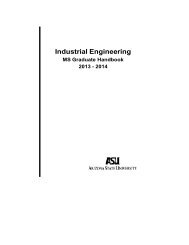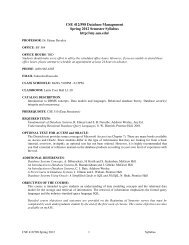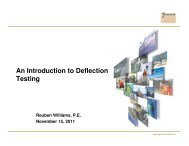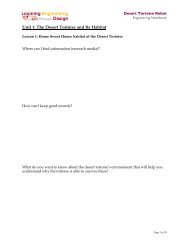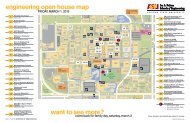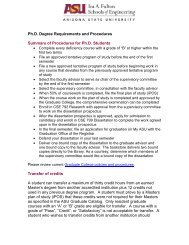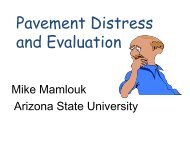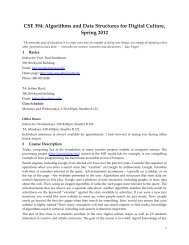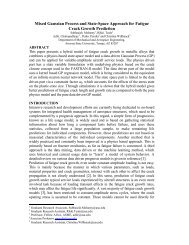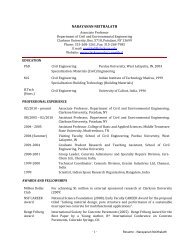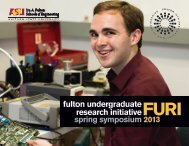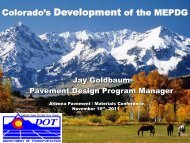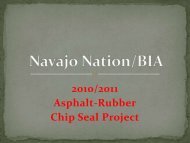2003-2004 Department of Computer Science and Engineering
2003-2004 Department of Computer Science and Engineering
2003-2004 Department of Computer Science and Engineering
Create successful ePaper yourself
Turn your PDF publications into a flip-book with our unique Google optimized e-Paper software.
Reseach CentersStorytelling is an important part <strong>of</strong> culturesaround the world, but the arrival <strong>of</strong>computers <strong>and</strong> other technologies has notsignificantly changed literature. Sundaramuses mathematical models to develop newways to communicate meaning in books.He also employs computational models tolook at communicating meaning in othertypes <strong>of</strong> documents. One project examinesways to encourage people to annotatedigital photos, which usually have nonsensefilenames. Sundaram hopes to create asystem in which after the user tells thecomputer something about the photo, thecomputer can express something about theuser <strong>and</strong> photo that the user did not know.“The humanities end up asking different <strong>and</strong>pr<strong>of</strong>ound questions about the models developed inengineering that force us to reevaluate,” Sundaramsaid. “This questioning by our collaborators broadensour research vision <strong>and</strong> allows us to construct muchmore sophisticated models.”But research is only one component <strong>of</strong> AME. Theprogram also allows students the opportunity to work<strong>and</strong> learn in an interdisciplinary environment. Thedem<strong>and</strong> for talented workers in multimedia is growing,particularly in entertainment but also in security <strong>and</strong>medicine. In fall <strong>2004</strong> CSE will begin to <strong>of</strong>fer master’s<strong>and</strong> Ph.D. degrees with concentrations in Media <strong>and</strong>Arts. Students will take classes in computer science<strong>and</strong> the arts as well as courses that bridge the twodisciplines.The Arts, Media <strong>and</strong> <strong>Engineering</strong> Program grew out<strong>of</strong> the Distributed Media <strong>and</strong> Arts laboratory, which wasestablished in 2001. Although a joint project <strong>of</strong> theFulton School <strong>of</strong> <strong>Engineering</strong> <strong>and</strong> Herberger College <strong>of</strong>Fine Arts, AME also includes researchers from severalliberal arts disciplines. Such an interdisciplinary venturehas both benefits <strong>and</strong> challenges.One <strong>of</strong> the biggest advantages <strong>of</strong> AME is that itallows researchers to see their work used in actualperformances. Artists <strong>and</strong> engineers almost speakdifferent languages, however, so researchers haveworked to underst<strong>and</strong> one another.“The arts don’t have the formalism present inscience, but the challenge in both arts <strong>and</strong> science isthe communication <strong>of</strong> meaning,” Sundaram said. “Itcomes down to the fundamental problem <strong>of</strong> humancommunication.”AME’s motion analysis team has been awarded twoprestigious grants in the past year for theirgroundbreaking work in dance analysis <strong>and</strong> interactiveart tools. The motion analysis team at AME wasawarded a National <strong>Science</strong> Foundation CISEresearch infrastructure grant. The CISE researchinfrastructure grant is the first for ASU. The motionanalysis team at AME was awarded a National<strong>Science</strong> Foundation CISE research infrastructure grantin the amount <strong>of</strong> $1.4 million. The CISE researchinfrastructure grant is the first for ASU.ARIZONA STATE UNIVERSITY 19



